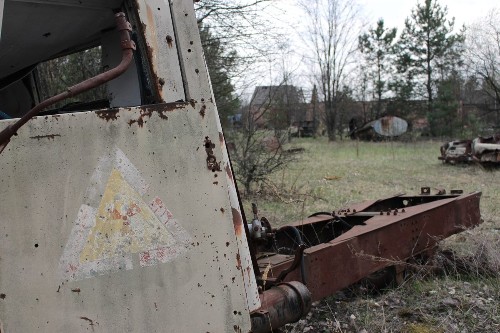
Abandoned vehicle inside the Chornobyl Exclusion Zone following the immediate aftermath response by 'liquidation'. Dr Yannick Verbelen
A team of Bristol scientists will reinstate and improve radiological monitoring systems within the Chornobyl Exclusion Zone (ChEZ) and inside the Chornobyl Nuclear Power Plant (ChNPP), impacted by the Russian invasion.
Part of the NATO Science for Peace and Security (SPS), the NATO-funded programme comprises multiple strands in response to both recent and legacy situations across one of the most radioactive environments on the planet. One such tranche will work to address the increased threat of extremist and state-sponsored groups acquiring and utilising unconventional weapons, including improvised nuclear explosive and radiological dispersion devices - such as dirty bombs - highlighted recently and more prominently by the war.
The continued threat of attacks on individuals, infrastructure and the public have highlighted the global vulnerability and the need for the next generation of radiological monitoring systems through which to rapidly and non-intrusively screen people and vehicles for nuclear and radioactive material, alongside a capability to respond to a contaminating event post-incident.
Despite global advancements in detector physics, 'big data' and cloud computing, the radiation detection, monitoring and response provision to protect infrastructure and populations from the catastrophic effects of an intentional dispersion of radioactive material has yet to catch-up. These same cutting edge advanced sensor technologies, when combined with robotic platform and cloud computing, can also be used to address a number of the decommissioning challenges in and around the ChNPP site, as the on-site operations accelerate following the successful installation of the multi-billion-dollar 'New Safe Confinement' structure that encases the crippled reactor unit four that infamously exploded in March 1986.
Project Lead Dr Peter Martin, a Royal Academy of Engineering Research Fellow, said: "This is an incredibly timely project, with the award of funding from NATO to sponsor this joint UK-Ukraine research enabling scientists and engineers from both countries to collaborate across a number of key nuclear and radiation detection challenges.
"We have worked with colleagues from across Ukraine for a number of years and are excited to work with them through this award to restore and advance their native capabilities."
The UK is a global leader in nuclear science and engineering developed over many decades – with the Bristol team having undertaken many visits to the Chornobyl Sarcophagus and Chornobyl Exclusion Zone as part of their research. Prior to the war in Ukraine and Russian occupation of both the ChEZ and ChNPP, a delegation from a number of Ukrainian nuclear organisations and the British Ambassador to Ukraine visited Bristol in January 2022, culminating in the signing of a Memorandum of Understanding between both organisations.
Deputy Project Lead in Ukraine Dr Viktor Krasnov commented: "In addition to the development of new technologies, which will provide the expected high contribution to improving radiation and nuclear safety at nuclear power facilities, the launch of this project at such a difficult time for Ukraine shows an example of real and effective support for Ukrainian science. The implementation of this project in the most difficult conditions of the post-accident Chornobyl is a guarantee of solving similar problems in any corner of the world."
The multi-year project brings together expertise from the University of Bristol's School of Physics, its Interface Analysis Centre research group, and the university-wide South West Nuclear Hub (SWNH) alongside partners from industry, as well as collaborators from the Institute for Safety Problems at Nuclear Power Plants (ISPNPP) of the National Academy of Sciences of Ukraine (NASU).






